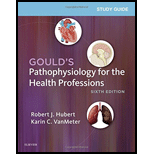
Concept explainers
To define: The meaning of opportunistic.
Introduction: Tissue transplant rejection is one of the main challenges faced in organ transplantation. Tissue transplant rejection is a process in which the immune system of the recipient rejects and attacks the transplanted organ or tissue. The rejection happens because of the recognition of transplanted organ as foreign (identified as non-self by recipient’s immune system) due to the presence of varied antigens (HLA antigens) in the cell surface of transplant.
To explain: The way in which opportunistic infection occurs as a common adverse effect of immunosuppressant drugs.
Introduction: Arrays of microbes that colonize in the body surface of an organism are called as normal microbiome. Certain surfaces are colonized with a combination of microbes (bacteria and
Want to see the full answer?
Check out a sample textbook solution
Chapter 7 Solutions
Study Guide for Gould's Pathophysiology for the Health Professions
- skin assessmentarrow_forwardIs this sinus arrest,sinus tachycardia,sinus bradycardia,normal sinus ?arrow_forwardRelated research design to answer the clinical question “How registered nurses accurately measure respiratory rates in performing vital sign assessments in hospital?” Provide article title, purpose/aim, methods and key findingarrow_forward
- Anything else I should add to this slide and notes? Can you also put the notes into paragraphs with the changes?arrow_forwardHow are the nervous and musculoskeletal systems interrelated? How do central nervous system abnormalities and damage to the musculoskeletal system affect mobility? Please cite in text source and list referencesarrow_forwardAnything else I should add to this slide and notes? Can you also put the notes into paragraphs with the changes?arrow_forward
- Anything else I should add to this slide and notes? Can you also put the notes into paragraphs with the changes?arrow_forwardAnything else I should add to this slide and notes? Can you also put the notes into paragraphs with the changes?arrow_forwardAnything else I should add to this slide and notes? Can you also put the notes into paragraphs with the changes?arrow_forward
- Anything else I should add to this slide? Can you also put the notes into paragraphs?arrow_forwardMake a nursing care plan include cognitive goal, affective goal, psychomotor goal, cognitive, affective, psychomotor interventions, and rationale for each Cognitive (Independent Interventions) Cognitive (Dependent Interventions) Cognitive (Collaborative Interventions) Affective (Independent Interventions) Affective (Dependent Interventions) Affective (Collaborative Interventions) Psychomotor (Independent Interventions) Psychomotor (Dependent Interventions) Psychomotor (Collaborative Interventions) Nursing Diagnosis: Acute pain related to post operative surgery as evidenced by guarding and facial grimace Chief Complaints: Hypogastric pain history of present illness2 months prior to consultation the patient complained of abdominal pain associated with discomfort, she was admitted to the ER but was discharged with unrecalled medications. 1 month prior to consultation the patient had moderate to severe dysmenorrhea, a whole abdominal ultrasound was performed and the results indicated…arrow_forwardMake a nursing care plan include Cognitive, affective, and psychomotor GOALS, cognitive, affective, psychomotor interventions, and rationale for each Cognitive (Independent Interventions) Cognitive (Dependent Interventions) Cognitive (Collaborative Interventions) Affective (Independent Interventions) Affective (Dependent Interventions) Affective (Collaborative Interventions) Psychomotor (Independent Interventions) Psychomotor (Dependent Interventions) Psychomotor (Collaborative Interventions) Nursing Diagnosis: Acute pain related to post operative surgery as evidenced by guarding and facial grimace Chief Complaints: Hypogastric pain history of present illness2 months prior to consultation the patient complained of abdominal pain associated with discomfort, she was admitted to the ER but was discharged with unrecalled medications. 1 month prior to consultation the patient had moderate to severe dysmenorrhea, a whole abdominal ultrasound was performed and the results indicated the…arrow_forward
 Phlebotomy EssentialsNursingISBN:9781451194524Author:Ruth McCall, Cathee M. Tankersley MT(ASCP)Publisher:JONES+BARTLETT PUBLISHERS, INC.
Phlebotomy EssentialsNursingISBN:9781451194524Author:Ruth McCall, Cathee M. Tankersley MT(ASCP)Publisher:JONES+BARTLETT PUBLISHERS, INC. Gould's Pathophysiology for the Health Profession...NursingISBN:9780323414425Author:Robert J Hubert BSPublisher:Saunders
Gould's Pathophysiology for the Health Profession...NursingISBN:9780323414425Author:Robert J Hubert BSPublisher:Saunders Fundamentals Of NursingNursingISBN:9781496362179Author:Taylor, Carol (carol R.), LYNN, Pamela (pamela Barbara), Bartlett, Jennifer L.Publisher:Wolters Kluwer,
Fundamentals Of NursingNursingISBN:9781496362179Author:Taylor, Carol (carol R.), LYNN, Pamela (pamela Barbara), Bartlett, Jennifer L.Publisher:Wolters Kluwer, Fundamentals of Nursing, 9eNursingISBN:9780323327404Author:Patricia A. Potter RN MSN PhD FAAN, Anne Griffin Perry RN EdD FAAN, Patricia Stockert RN BSN MS PhD, Amy Hall RN BSN MS PhD CNEPublisher:Elsevier Science
Fundamentals of Nursing, 9eNursingISBN:9780323327404Author:Patricia A. Potter RN MSN PhD FAAN, Anne Griffin Perry RN EdD FAAN, Patricia Stockert RN BSN MS PhD, Amy Hall RN BSN MS PhD CNEPublisher:Elsevier Science Study Guide for Gould's Pathophysiology for the H...NursingISBN:9780323414142Author:Hubert BS, Robert J; VanMeter PhD, Karin C.Publisher:Saunders
Study Guide for Gould's Pathophysiology for the H...NursingISBN:9780323414142Author:Hubert BS, Robert J; VanMeter PhD, Karin C.Publisher:Saunders Issues and Ethics in the Helping Professions (Min...NursingISBN:9781337406291Author:Gerald Corey, Marianne Schneider Corey, Cindy CoreyPublisher:Cengage Learning
Issues and Ethics in the Helping Professions (Min...NursingISBN:9781337406291Author:Gerald Corey, Marianne Schneider Corey, Cindy CoreyPublisher:Cengage Learning





